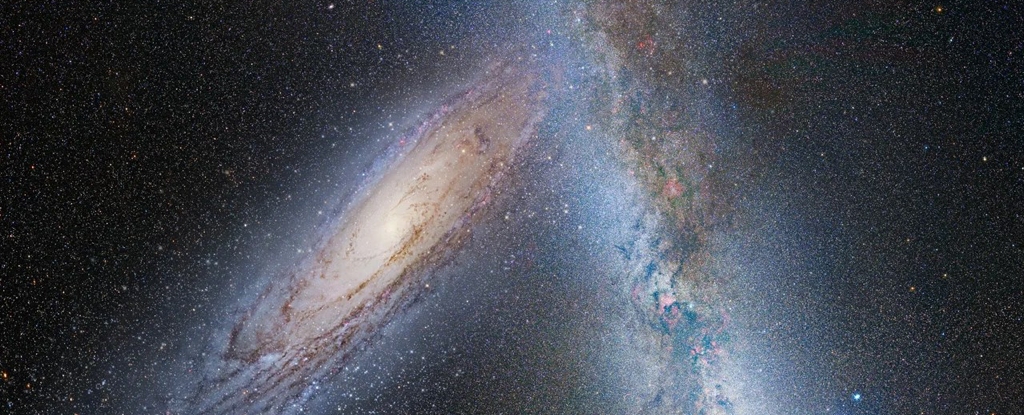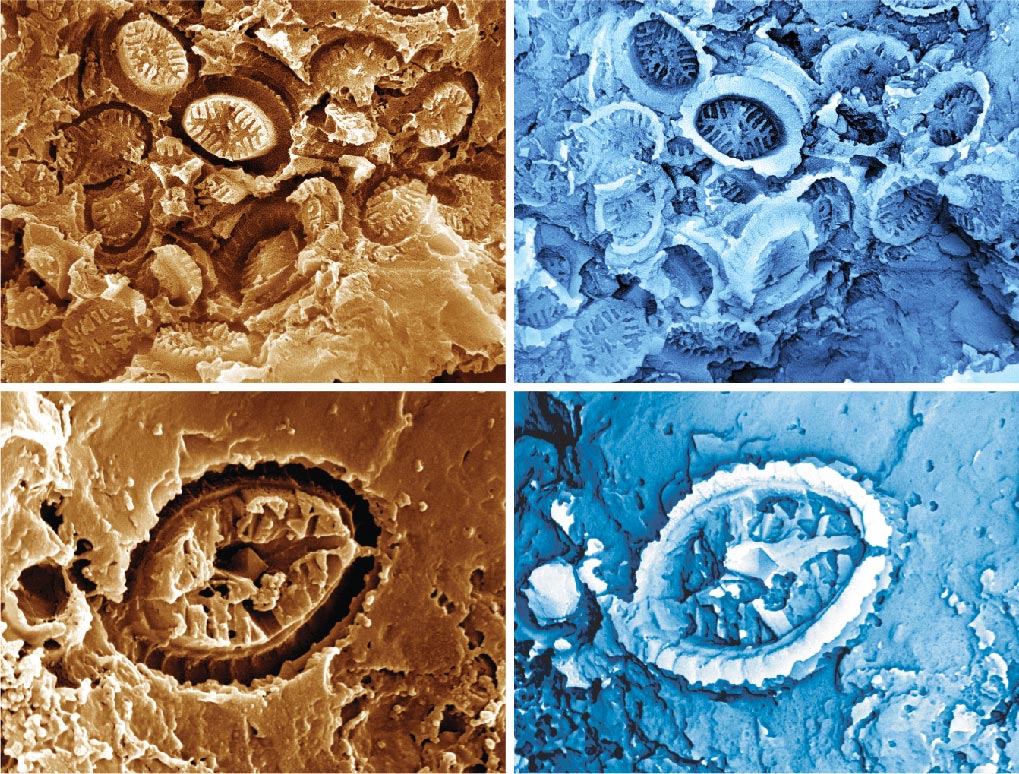
Слике показују утиске срушеног покривача ћелијског зида (кокосфере) на површини фрагмента древне органске материје (лево) са појединачним увећаним плочама (кокцикс) како би се показало изузетно очување структура субмикронске скале (десно). Плава слика је обрнута да би се добила виртуелна фосилна слика, односно да би се приказао оригинални 3Д облик. Оригиналне плоче су уклоњене из седимента растварањем, остављајући за собом само трагове духова. Заслуге: С.М. Слатер, П. Бовен/Сциенце Јоурнал
Међународни тим истраживача открио је нову врсту фосилизације.
Откриће фосила ‘духова’ открива отпорност планктона у суочавању са прошлим догађајима глобалног загревања.
Међународни тим научника са Универзитетског колеџа у Лондону (УЦЛ), Шведског природњачког музеја, Природњачког музеја (Лондон) и Универзитета у Фиренци пронашао је изузетан тип фосилизације који је до сада остао практично непримећен.
Фосили су микроскопски отисци прстију или „духови“ једноћелијског планктона, названог коколитофори, који су живели у морима пре милионима година, а њихово откриће је револуционисало наше разумевање о томе како климатске промене утичу на планктон у океанима.
Коколитофори су важни у данашњим океанима, обезбеђујући већи део кисеоника који удишемо, подржавајући морске мреже хране и задржавајући угљеник у седиментима морског дна. Они су врста микроскопског планктона који своје ћелије окружује тврдим кречњачким плочама, званим коколити, које се обично разлажу у стенама.
Смањење обиља ових фосила је документовано из неколико догађаја пре глобалног загревања, што указује да су ови планктон озбиљно погођен климатским променама и закисељавањем океана. Међутим, студија је објављена данас у часопису Наука Представља нове светске рекорде за обиље три фосила духова[{“ attribute=““>Jurassic and Cretaceous warming events (94, 120, and 183 million years ago), suggesting that coccolithophores were more resilient to past climate change than was previously thought.

The individual plates are coccoliths. Credit: Images from Nannotax https://www.mikrotax.org/Nannotax3/
“The discovery of these beautiful ghost fossils was completely unexpected,” says Dr. Sam Slater from the Swedish Museum of Natural History. “We initially found them preserved on the surfaces of fossilized pollen, and it quickly became apparent that they were abundant during intervals where normal coccolithophore fossils were rare or absent – this was a total surprise!”
Despite their microscopic size, coccolithophores can be hugely abundant in the present ocean, being visible from space as cloud-like blooms. After death, their calcareous exoskeletons sink to the seafloor, accumulating in vast numbers, and forming rocks such as chalk.

The fossils are approximately 5 µm in length, 15 times narrower than the width of a human hair. Credit: S.M. Slater, P. Bown et al. / Science journal
“The preservation of these ghost nannofossils is truly remarkable,” says Professor Paul Bown (UCL). “The ghost fossils are extremely small ‒ their length is approximately five-thousandths of a millimeter, 15 times narrower than the width of a human hair! ‒ but the detail of the original plates is still perfectly visible, pressed into the surfaces of ancient organic matter, even though the plates themselves have dissolved away.”
The ghost fossils formed while the sediments at the seafloor were being buried and turned into rock. As more mud was gradually deposited on top, the resulting pressure squashed the coccolith plates and other organic remains together, and the hard coccoliths were pressed into the surfaces of pollen, spores, and other soft organic matter. Later, acidic waters within spaces in the rock dissolved away the coccoliths, leaving behind just their impressions – the ghosts.

Ghost nannofossils were found in rocks from global warming intervals where normal coccolithophore fossils were rare or absent. Credit: S.M. Slater, P. Bown, et al. / Science journal
“Normally, paleontologists only search for the fossil coccoliths themselves, and if they don’t find any then they often assume that these ancient plankton communities collapsed,” explains Professor Vivi Vajda (Swedish Museum of Natural History). “These ghost fossils show us that sometimes the fossil record plays tricks on us and there are other ways that these calcareous nannoplankton may be preserved, which need to be taken into account when trying to understand responses to past climate change.”
Professor Silvia Danise (University of Florence) says: “Ghost nannofossils are likely common in the fossil record, but they have been overlooked due to their tiny size and cryptic mode of preservation. We think that this peculiar type of fossilization will be useful in the future, particularly when studying geological intervals where the original coccoliths are missing from the fossil record.”

Ghost nannofossils were found globally, in rocks from three rapid warming events in Earth’s history (the T-OAE, OAE1a, and OAE2). Credit: S.M. Slater et al.
The study focused on the Toarcian Oceanic Anoxic Event (T-OAE), an interval of rapid global warming in the Early Jurassic (183 million years ago), caused by an increase in CO2-levels in the atmosphere from massive volcanism in the Southern Hemisphere. The researchers found ghost nannofossils associated with the T-OAE from the UK, Germany, Japan, and New Zealand, but also from two similar global warming events in the Cretaceous: Oceanic Anoxic Event 1a (120 million years ago) from Sweden, and Oceanic Anoxic Event 2 (94 million years ago) from Italy.
“The ghost fossils show that nannoplankton were abundant, diverse, and thriving during past warming events in the Jurassic and Cretaceous, where previous records have assumed that plankton collapsed due to ocean acidification,” explains Professor Richard Twitchett (Natural History Museum, London). “These fossils are rewriting our understanding of how the calcareous nannoplankton respond to warming events.”
Finally, Dr. Sam Slater explains: “Our study shows that algal plankton were abundant during these past warming events and contributed to the expansion of marine dead zones, where seafloor oxygen-levels were too low for most species to survive. These conditions, with plankton blooms and dead zones, may become more widespread across our globally warming oceans.”
Reference: “Global record of “ghost” nannofossils reveals plankton resilience to high CO2 and warming” by Sam M. Slater, Paul Bown, Richard J. Twitchett, Silvia Danise and Vivi Vajda, 19 May 2022, Science.
DOI: 10.1126/science.abm7330

„Љубитељ пива. Предан научник поп културе. Нинџа кафе. Зли љубитељ зомбија. Организатор.“




/cdn.vox-cdn.com/uploads/chorus_asset/file/24931352/236792_iPhone_15_Pro_and_15_Pro_Max_product_photos_AJohnson_0008.jpg)


More Stories
Према фосилима, праисторијску морску краву појели су крокодил и ајкула
Коначну судбину Млечног пута може одредити бацање новчића: СциенцеАлерт
Када ће астронаути лансирати?